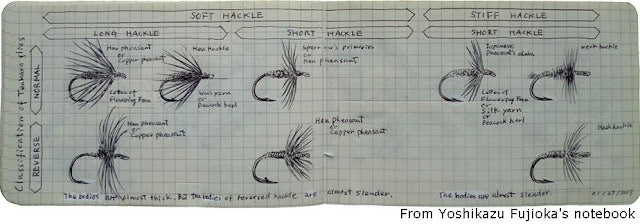Some people consider winter the fly-tying season, thus our recent posts on tenkara fly-tying. With the very large number of new tenkara adopters and readers of our blog since this the post below, I thought it would be appropriate to "recycle" a previous post on "Tenkara Flies analyzed". This is not to form a habit, but there is some really good content in past posts...maybe a book in the making? Originally posted on June 25th, 2009. Slightly edited here: While the most characteristic tenkara flies are the so-called "sakasa kebari", or reverse hackle flies, these are not the only type of fly used in tenkara. Over the years, Mr. Yoshikazu Fujioka, has researched and collected traditional tenkara flies from different regions of Japan. Now, Fujioka sensei gives us a very nice, yet, tenkara-like simple, analysis of tenkara flies. Like classifying western flies into "dry", "wet", "nymphs", etc, his analysis focuses specifically on tenkara flies and what pattern styles are commonly found in the hands of tenkara anglers. These should serve as a good foundation to better understanding tenkara flies (if one chooses to, understanding this is not really necessary to be a successful angler). As shown in his graphic chart, even the sakasa kebari come in different forms and with different characteristics (soft hackle/stiff hackle, thick body/thin body and short/long hackle).
Typically, an experienced tenkara angler will use one pattern only. Over time, an angler will acquire preferences for a specific fly type, and will have his sole "go-to" fly, maybe a couple of different sizes and colors, but the same pattern. Not all tenkara anglers use the same fly, but each one tends to stick with only one style. Some may believe a fly with soft hackle will be more "fluid", softer and thus may be more attractive; other people may believe a stiffer hackle facing forward is better. There is even an angler who uses snake skin to tie his flies, and he believes the reflection of the snake skin attracts fish (we just think it is a cool story!). This is largely personal preference, or maybe because of that "one great day with the one fly" they experienced. The complete analysis of tenkara fly by Fujioka sensei can be found on the pdf document. It's very informative and thorough, yet simple as it should be.
